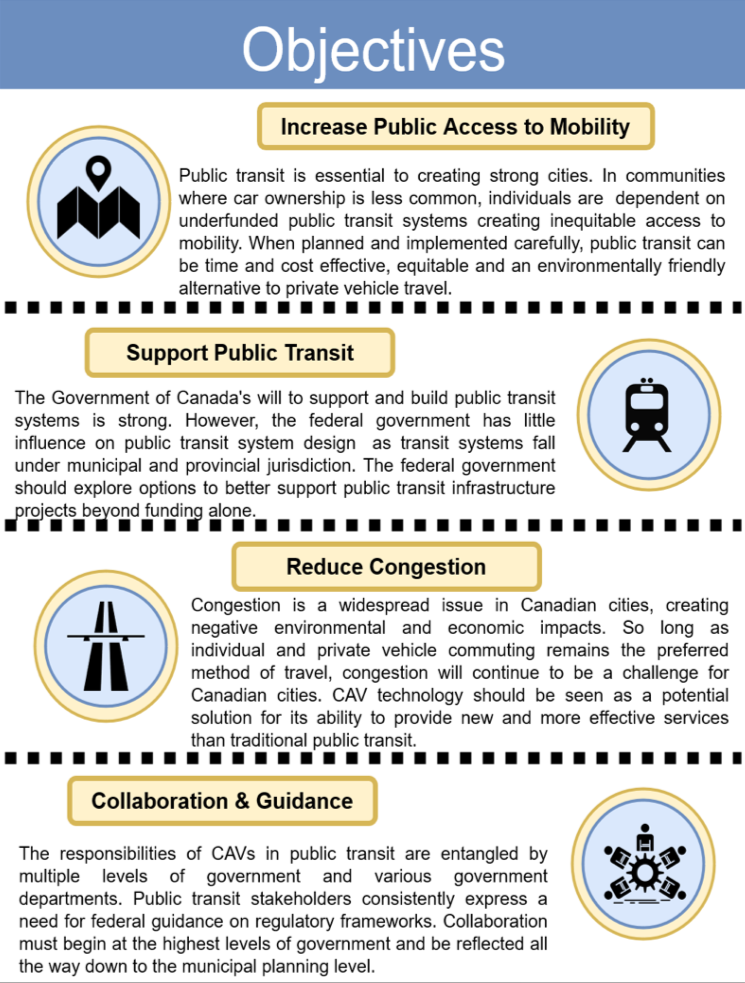This is the executive summary of the Connected Autonomous Vehicles in Public Transit report. You can access the full Policy Lab report here.
The policy challenge, provided by Infrastructure Canada, focused on how the adoption and integration of connected and autonomous vehicles (CAVs) into Canadian public transit systems will impact urban mobility. The original challenge called for the development of a suite of policy recommendations for each level of government. As the challenge evolved, the objective shifted towards the creation of a jurisdictional dashboard with a focus on policy options for the federal government.
The research for this policy brief was done through a literature review consisting of peer-reviewed journal articles, reports produced by industry associations, technical organizations, and stakeholders in addition to materials produced by federal, provincial, and municipal governments. Our review was complemented by a series of interviews with Infrastructure Canada and industry stakeholders.
This policy brief addresses opportunities and challenges presented by CAV technology. The potential impacts on transit systems and cities are explored in depth. Understanding the impact CAVs will have on land use patterns and infrastructure needs will help guide urban planning for the future of CAVs. Following this is an analysis of important considerations regarding vulnerable populations, the environment, and the economy.
Our research and stakeholder interviews led us to four high-level objectives that we believe all levels of government should strive to achieve with the integration of CAVs into public transit systems.
We believe that these objectives will be integral for maximizing the potential benefits of CAVs. Each recommendation of the policy brief seeks to realize at least one of these objectives in Canada.
Central to achieving each objective is a clear understanding of the jurisdictional responsibilities of each level of government. The brief details the role each level of government could play in solving this complex policy challenge. We outline each level of government’s primary responsibilities and concerns providing policy opportunities available to provincial and municipal governments.

We have determined three categories of recommendations for the federal government:
1. Research & Development
To ensure successful deployment of CAVs in public transit systems, knowledge gaps need to be addressed. We propose the federal government could divest funding to projects that help support research, knowledge sharing, collaboration, and the development of projects in the following recommendations:
- Recommendation #1 : Establish a CAV Transit Challenge
- Recommendation #2: Study mobility pricing
- Recommendation #3: Support solutions to first mile/last mile challenges
- Recommendation #4: Support the study of CAV impact on urban spaces
2. Stakeholder Collaboration
Strong collaboration amongst private/public stakeholders and public transit users will be crucial. We propose Infrastructure Canada could lead collaboration in the following recommendations:
- Recommendation #5: Establish a CAV forum for relevant government departments and create a public and private forum for all stakeholders to collaborate
- Recommendation #6: Work to increase social acceptability of CAV technology
3. Safety & Testing Standards
To optimize the true potential of CAVs, safety standards and adequate testing must be a priority. To ensure that safety and testing remain at the forefront of adoption efforts we propose the following recommendations:
- Recommendation #7: Assist in the establishment of public transit safety standards
- Recommendation #8: Support CAV testing facilities
This Policy Lab was presented by our MPPs on July 9, 2020. Watch the video below:
About the Authors

Kayli Avveduti
MPP Class of 2020
 Benjamin Dooley
Benjamin Dooley
MPP Class of 2020
 Jasmine Kaur
Jasmine Kaur
MPP Class of 2020

Kathryn Lemieux
MPP Class of 2020
 Jameson Voisin
Jameson Voisin
MPP Class of 2020




